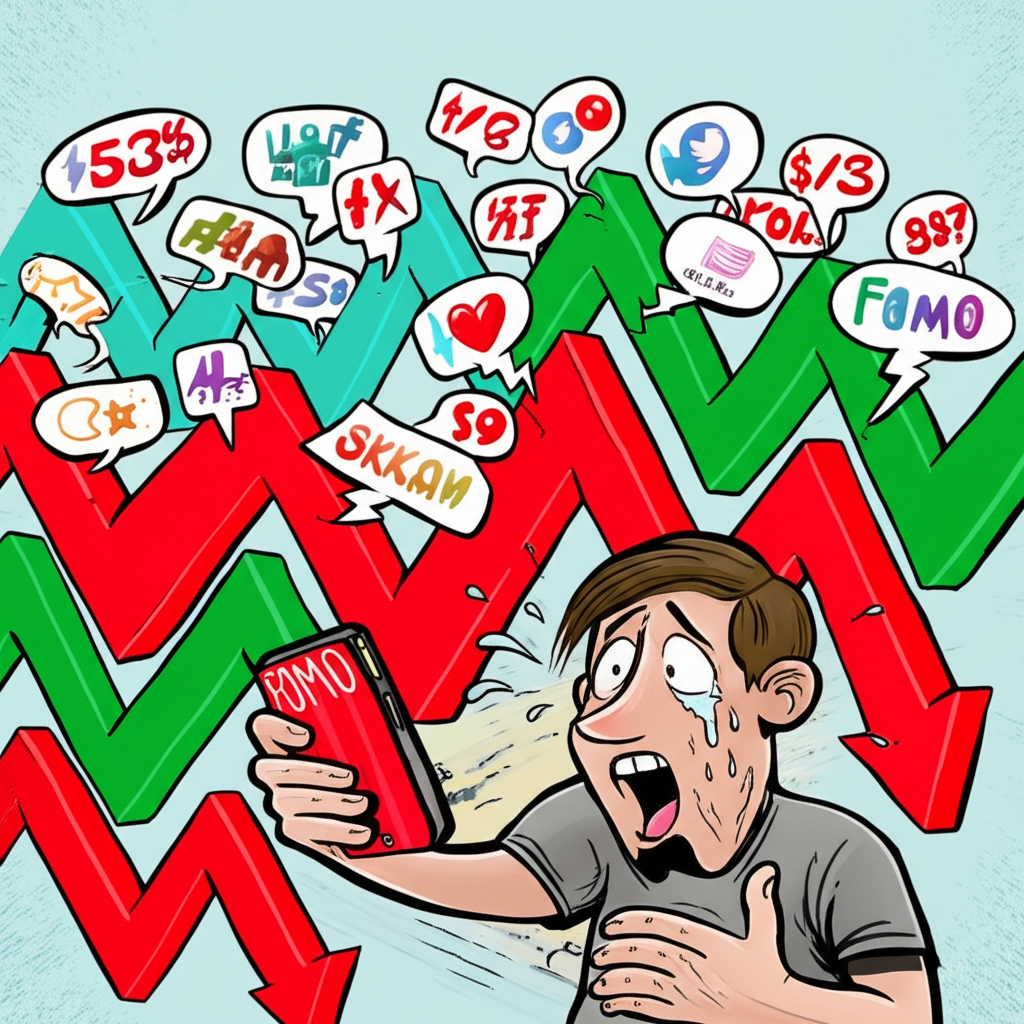Introduction: What Exactly Defines a Meme Stock?

A meme stock isn’t defined by quarterly earnings, revenue growth, or balance sheet strength. Instead, it’s a stock that surges in value not because of corporate performance, but because it captures the imagination of online communities. These equities rise on the back of viral attention—fueled by platforms like Reddit, Twitter, and TikTok—where retail investors band together to push prices upward, often in defiance of conventional financial logic. The term “meme stock” reflects this cultural origin: like an internet meme, the stock spreads rapidly through shared enthusiasm, humor, and digital camaraderie. What sets these stocks apart is their detachment from traditional valuation metrics. Instead of analyst ratings or institutional buying, their momentum comes from collective sentiment, social media virality, and the thrill of challenging Wall Street’s established order. This shift has introduced a new dynamic into financial markets, one where individual investors, armed with smartphones and group coordination, can influence asset prices in ways once reserved for hedge funds and brokerage houses.
The Rise of Meme Stocks: A History of Collective Action
From Niche Forums to Mainstream Influence: The Origins

The meme stock movement didn’t emerge in boardrooms or trading floors—it was born in digital undergrounds. Online communities, particularly Reddit’s r/wallstreetbets, became breeding grounds for a new kind of market behavior. What started as a forum for retail traders to share wild bets and trading memes gradually evolved into a platform for coordinated action. Here, users didn’t just discuss stocks—they rallied around them, turning obscure or struggling companies into financial battlegrounds. The rise of commission-free trading apps like Robinhood, Webull, and eToro accelerated this shift by removing cost barriers and simplifying access. Suddenly, anyone with a smartphone could buy shares instantly, often with fractional ownership, making the stock market feel less like an exclusive club and more like a participatory event. The fusion of internet culture and investing created a feedback loop: a post about a heavily shorted stock would go viral, sparking FOMO (fear of missing out), which drove buying, which in turn fed more online discussion. This cycle transformed stocks into symbols—less about company value and more about community identity and rebellion.
The GameStop Phenomenon: A Case Study in Disruption
Few moments in modern finance have been as explosive as the GameStop saga of early 2021. GameStop, a brick-and-mortar video game retailer facing obsolescence in the digital age, had become a prime target for short sellers. Hedge funds had bet heavily on its decline, with over 100% of its float sold short—a rare and risky position. But members of r/wallstreetbets noticed this imbalance and saw an opportunity. They began aggressively buying shares and call options, not necessarily because they believed in the company’s long-term future, but to force a short squeeze. As the stock price climbed—from under $20 to over $480 in a matter of weeks—short sellers were forced to buy back shares at skyrocketing prices to cover their positions. The resulting cascade sent shockwaves through Wall Street, wiping out billions in hedge fund value and thrusting retail investors into the spotlight. The event wasn’t just about money; it became a cultural moment, symbolizing a populist uprising against financial elites. Other companies like AMC Entertainment followed a similar path, with retail investors driving massive rallies based on loyalty, nostalgia, and a shared sense of mission. The GameStop episode proved that coordinated retail action, when amplified by social media, could disrupt even the most entrenched market players.
How Meme Stocks Operate: Dynamics of Sentiment and Volatility
The Amplifying Power of Social Media and Online Communities

At the heart of every meme stock rally lies a digital echo chamber. Platforms like Reddit, Twitter (now X), and TikTok don’t just spread information—they amplify emotion. A single viral post or video can ignite a buying frenzy, especially when it taps into themes of injustice, underdog triumph, or financial liberation. Unlike traditional market drivers such as earnings reports or Fed announcements, meme stock momentum is often sparked by sentiment, humor, or a rallying cry like “to the moon.” These online spaces foster a sense of belonging and shared purpose, encouraging users to act collectively. The speed at which information travels online means that price movements can be nearly instantaneous. A post at midnight can lead to a 50% surge by morning. Algorithms further accelerate this process by promoting trending content, creating a self-sustaining cycle of attention and speculation. In this environment, narratives matter more than fundamentals. A company doesn’t need to be profitable—it just needs a compelling story that resonates with the crowd.
Understanding Short Squeezes and Extreme Price Swings
A short squeeze is the engine behind many meme stock surges. When a large number of investors bet against a stock by shorting it, they create vulnerability. If the stock begins to rise—often due to unexpected retail buying—short sellers face mounting losses. To limit damage, they must buy shares to close their positions. But this buying pressure drives the price even higher, forcing more shorts to cover, creating a feedback loop. Meme stocks often meet the perfect conditions for this: high short interest, low liquidity, and a catalyst—usually social media mobilization. The result is extreme volatility. Prices can double or triple in hours, only to collapse just as quickly once momentum fades. This isn’t investing in the traditional sense; it’s more akin to a high-stakes game of momentum trading. For example, GameStop’s stock saw daily swings of 50% or more during its peak, making it nearly impossible to predict or manage risk using conventional methods. Such volatility rewards timing and luck over analysis, turning meme stocks into speculative instruments rather than long-term holdings.
Retail Empowerment vs. Market Stability: The Regulatory Debate
The rise of meme stocks has sparked a heated debate about fairness, stability, and the future of financial regulation. On one side, supporters argue that retail investors are finally leveling the playing field. For decades, market movements were dictated by institutional money and insider access. Now, collective action by ordinary people can challenge that dominance, bringing transparency and accountability. Some view the GameStop rally not as manipulation, but as a legitimate form of market expression—a way to expose excessive shorting or questionable analyst calls. On the other side, regulators and financial experts warn of systemic risks. When stock prices detach completely from fundamentals, markets lose their efficiency. There’s also concern about market manipulation, especially when coordinated groups use misleading information to pump prices. The U.S. Securities and Exchange Commission (SEC) has taken a close look at these dynamics, questioning whether current rules are equipped to handle social media-driven trading surges. While no major crackdown has occurred, the scrutiny highlights a growing tension: how to protect market integrity without stifling retail participation in an increasingly digital financial world.
Risks and Considerations: Navigating the Meme Stock Market
The Significant Dangers for Unwary Investors
Jumping into meme stocks without understanding the risks is like stepping onto a rollercoaster blindfolded. These assets are among the most volatile in the market, capable of delivering life-changing gains—or devastating losses—in a matter of days. Because their prices are driven by sentiment rather than earnings, there’s no reliable way to determine fair value. Once the hype dies down, prices often crash back to pre-rally levels, leaving latecomers with massive losses. Many investors who bought GameStop or AMC at their peaks in 2021 saw their portfolios shrink by 80% or more in the following months. The Financial Industry Regulatory Authority (FINRA) has issued clear warnings: “Stocks with high volatility, especially those driven by social media buzz, can lose value quickly.” Many participants fall victim to emotional trading—buying out of FOMO, holding through panic, and selling at the worst possible time. For inexperienced investors, the allure of quick riches can overshadow the reality of risk, turning what feels like a sure bet into a costly lesson.
Meme Stocks vs. Traditional Investing: A Philosophical Divide
Meme stock investing and traditional investing are built on entirely different foundations. Conventional investing relies on research, patience, and discipline. Analysts pore over financial statements, assess competitive advantages, and project future cash flows to estimate a company’s intrinsic value. Investors then buy with the expectation that the market will eventually recognize that value, leading to steady appreciation over time. Diversification, risk management, and long-term planning are central to this approach. Meme stock investing, by contrast, often rejects these principles. Decisions are based on online chatter, community sentiment, and the potential for explosive short-term gains. The goal isn’t to hold a stock for years—it’s to ride the wave while it lasts. This creates a fundamental mismatch in expectations and risk tolerance. While traditional investing aims to grow wealth steadily, meme stock trading is more speculative, resembling gambling than wealth building. Recognizing this difference is crucial for anyone trying to decide where they stand in the modern market landscape.
Strategies for Managing Risk in a Volatile Environment
While meme stocks are inherently risky, investors can take steps to limit potential damage. The most important rule is position sizing: only allocate a small portion of your portfolio—money you can afford to lose entirely. Treating meme stock investments as speculative plays, rather than core holdings, helps maintain balance. Diversification across asset classes—such as index funds, bonds, and real estate—can cushion the blow if a speculative bet goes south. It’s also critical to go beyond the hype. Just because a stock is trending on Reddit doesn’t mean it’s a good buy. Look at the company’s financials, understand its business model, and ask whether it has a path to long-term sustainability. Some traders use stop-loss orders to cap losses, though extreme volatility can render these ineffective during flash crashes. Above all, avoid emotional decision-making. Greed and fear are the enemies of sound judgment. The U.S. Securities and Exchange Commission (SEC) has emphasized this point: “If you’re investing based on social media hype, be prepared to lose your money.” Their official guidance urges investors to conduct independent research and think critically before jumping on any trend.
The Evolving Landscape: Examples and Future Outlook
Beyond the Classics: Other Notable Meme Stock Examples
While GameStop and AMC dominate the narrative, they’re far from the only players in the meme stock arena. A range of companies—from tech relics to struggling retailers—have been swept into the frenzy. These stocks often share common traits: high short interest, low market capitalization, and a compelling story that resonates with online communities.
| Company Name | Primary Industry | Key Factors Contributing to Meme Status |
| :——————– | :——————————- | :———————————————————————- |
| **AMC Entertainment** | Movie Theater Chain | High short interest, strong retail investor loyalty, cultural relevance |
| **BlackBerry (BB)** | Software & Cybersecurity | Nostalgia, perceived turnaround potential, online community engagement |
| **Bed Bath & Beyond (BBBY)** | Home Goods Retailer | High short interest, turnaround speculation, bankruptcy speculation |
| **Koss Corporation (KOSS)** | Headphone Manufacturer | Micro-cap, high short interest, correlated with GME movements |
| **Clover Health (CLOV)** | Healthcare Technology | High short interest, public scrutiny, retail investor push |
| **Nokia (NOK)** | Telecommunications & Tech | Global brand recognition, historical significance, low stock price |
These cases illustrate that almost any stock can become a meme target under the right conditions. Often, the companies involved are in decline or transition, making them ideal candidates for speculative bets. The narrative isn’t about turning the business around—it’s about the act of defiance, the thrill of the rally, and the power of collective action.
Meme Stocks and Cryptocurrencies: Parallel Phenomena?
The behavior surrounding meme stocks bears a striking resemblance to certain corners of the cryptocurrency world. Assets like Dogecoin and Shiba Inu were created as jokes but gained real value through community support and viral marketing. Like meme stocks, their prices are driven more by hype, celebrity endorsements, and online communities than by utility or fundamentals. Both markets attract similar participants: young, tech-savvy investors who value decentralization, distrust institutions, and seek outsized returns. Trading platforms often blur the lines further, allowing users to trade both stocks and crypto in the same app. This convergence has created a new breed of digital speculator—one who moves seamlessly between meme stocks and meme coins, chasing momentum wherever it appears. While some see this as a democratization of finance, others worry it fosters a culture of speculation over substance.
The Future of Meme Stocks: A Lasting Impact or Fleeting Trend?
The initial wave of meme stock mania may have cooled, but the forces behind it are here to stay. Online communities aren’t going away. Zero-commission trading is now standard. And retail investors have tasted their own power. While individual meme stocks may fade—many revert to pre-hype levels once the buzz dies—the phenomenon itself has permanently altered the financial landscape. Regulators will continue to grapple with how to respond. Should coordinated buying be policed? Can social media platforms be held accountable for financial misinformation? These questions remain unresolved. Meanwhile, retail investors are becoming more sophisticated, blending sentiment with basic analysis. Some may continue chasing short-term gains, while others use the tools of the meme stock movement to support companies they believe in. The lasting legacy of meme stocks isn’t any single rally—it’s the realization that in the digital age, market influence is no longer reserved for the elite. The crowd now has a voice, and it’s loud enough to move markets.
Conclusion: A New Era of Retail-Driven Markets
Meme stocks represent more than a financial anomaly—they symbolize a cultural shift in how people engage with markets. Fueled by social media, democratized trading platforms, and a desire for empowerment, these stocks have redefined what’s possible for retail investors. The GameStop episode proved that collective action, when amplified online, can challenge even the most powerful institutions. Yet, this newfound power comes with significant risk. The same forces that drive explosive gains can also lead to devastating losses, especially for those who don’t understand the game they’re playing. As the lines between investing, speculation, and digital culture continue to blur, one thing is clear: the financial world will never be the same. The rise of the retail investor isn’t a passing trend—it’s a transformation. Navigating this new era requires awareness, discipline, and a clear-eyed understanding of both the opportunities and dangers that come with it.
What exactly defines a “meme stock” in today’s financial markets?
A “meme stock” is a company’s stock that gains significant public attention and experiences rapid price increases, primarily driven by social media hype, online community sentiment, and retail investor coordination, rather than traditional financial fundamentals or company performance.
Why are these stocks referred to as “meme stocks,” tracing their cultural and financial origins?
They are called “meme stocks” because their popularity and trading momentum often originate from internet “meme” culture – viral jokes, images, or ideas shared rapidly across online platforms. This cultural phenomenon translated into finance as specific stocks became targets of collective attention and speculative trading, often fueled by communities like Reddit’s r/wallstreetbets.
What are some prominent examples of companies that have been classified as meme stocks?
The most prominent examples include GameStop (GME) and AMC Entertainment (AMC). Other notable companies that have experienced meme stock status include BlackBerry (BB), Bed Bath & Beyond (BBBY), Koss Corporation (KOSS), and Clover Health (CLOV).
Is it generally considered a good or bad investment strategy to buy meme stocks?
Generally, buying meme stocks is considered a highly speculative and risky investment strategy. While there’s potential for significant short-term gains, the lack of fundamental valuation support and extreme volatility mean there’s also a high probability of rapid and substantial capital loss. It is not considered a sound strategy for long-term, wealth-building investment.
What are the primary risks associated with investing in highly volatile meme stocks?
Primary risks include:
- High Capital Loss: Prices can plummet as quickly as they rise.
- Extreme Volatility: Unpredictable and rapid price swings make market timing nearly impossible.
- Lack of Fundamental Value: Prices are often detached from the company’s actual financial performance.
- Market Manipulation Concerns: The fine line between collective action and illicit market manipulation.
- Emotional Trading: FOMO and herd mentality can lead to poor decision-making.
How do social media platforms and online communities influence meme stock price movements?
Social media platforms and online communities act as powerful amplifiers. They facilitate the rapid spread of trading ideas, rally calls, and collective sentiment, which can lead to coordinated buying pressure. This collective action can trigger short squeezes and create significant upward momentum, largely driven by hype, FOMO, and herd mentality rather than traditional financial analysis.
Is a well-known company like Tesla considered a meme stock, and what factors determine this?
While Tesla (TSLA) has a highly passionate retail investor base and has experienced significant volatility, it is not typically classified as a pure “meme stock” in the same vein as GameStop. Factors determining this include:
- Tesla has strong underlying fundamentals, consistent revenue growth, and a clear business model.
- Its valuation, though high, is often tied to its innovation and market position, not solely online sentiment.
- While influenced by social media, its price movements are also heavily driven by traditional analyst coverage and institutional investment.
Meme stocks are generally defined by a lack of these traditional drivers.
How do meme stocks fundamentally differ from traditional investments based on company fundamentals?
Meme stocks differ from traditional investments in several key ways:
- Valuation Basis: Meme stocks are driven by sentiment and hype; traditional investments by financial health, earnings, and growth prospects.
- Volatility: Meme stocks exhibit extreme, unpredictable price swings; traditional investments typically have more stable, predictable movements.
- Investment Horizon: Meme stocks are often short-term speculative plays; traditional investments are usually for long-term growth.
- Risk Profile: Meme stocks are high-risk, high-reward; traditional investments aim for measured risk and consistent returns.
What role did retail trading platforms play in facilitating the meme stock phenomenon?
Retail trading platforms, particularly zero-commission apps like Robinhood, played a crucial role by democratizing access to the stock market. They made it incredibly easy and affordable for individual investors, including those with limited experience or capital, to buy and sell stocks rapidly. This accessibility, combined with user-friendly interfaces, lowered barriers to entry and allowed a massive influx of retail investors to participate in coordinated trading activities.
What is the long-term outlook for meme stocks, and are they likely to continue impacting markets?
The long-term outlook for individual meme stocks is often bleak, as their prices tend to revert to fundamental valuations once the hype fades. However, the phenomenon of meme stocks is likely to continue impacting markets. The underlying drivers—the power of online communities, accessible trading, and retail investor engagement—are enduring trends. While specific targets may change, the potential for social media-driven market events remains a significant factor that regulators, institutions, and individual investors must continue to monitor and understand.

留言